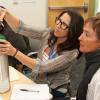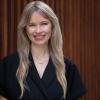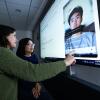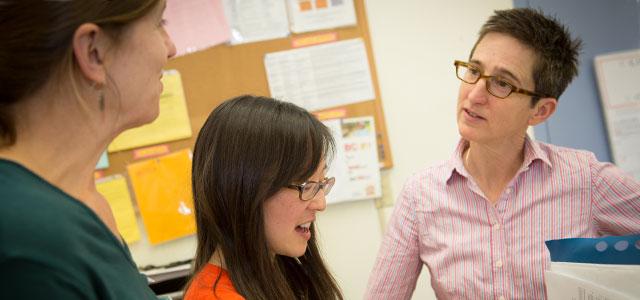
Beth Wilson, MD (right), with family nurse practitioners Naomi Schoenfeld (left) and Jennifer Liu (photos by Elisabeth Fall)
Bringing the Physician’s Perspective to Nurse Practitioner Training
Volunteer clinical faculty and preceptors offer students individual perspectives and hands-on experience in a variety of health care settings and specialties. The cumulative effect of what these volunteers impart plays a significant role in the care any health system delivers. This series aims to shed light on the unique roles these valuable mentors play.
This month, we hear from Elisabeth (Beth) Wilson, a physician and associate professor of family and community medicine at UC San Francisco School of Medicine, who since 2007 has co-taught a course at UC San Francisco School of Nursing (with JoAnne Saxe) on managing patients with chronic disease. In addition to her clinical practice at San Francisco General Hospital’s Family Health Center and her research on health disparities, Wilson recently stepped down from her position as program director of the Program in Medical Education for the Urban Underserved (PRIME-US), a five-year track for medical students interested in working with urban underserved populations. She has taken on a new position as director of education for the UC San Francisco Department of Family and Community Medicine.
After my undergraduate degree, I worked in the arts and only went to medical school later, after unexpected life events changed my path. I begged my way into the Tufts MD/MPH program because I was interested in working on community-based health issues and partnerships.
During medical school, I didn’t have a lot of experience with family medicine, but I understood there were some specialties dedicated to working directly with communities. Then, when I interviewed here at UCSF and saw family and community medicine based at San Francisco General, I loved the idea of working in an underserved setting while still being in an academic program. In family medicine, we can see anybody who walks in the door, so if we’re talking about access, family medicine just makes sense.
One of my faculty mentors was a health policy researcher, and after my residency I did a research fellowship where I could use my MPH more; I mostly focused on health disparities and workforce diversity, and that’s what eventually led me to medical school education. I love working with students from diverse backgrounds committed to reducing health disparities.
During my fellowship, I worked at Marin Community Clinics and somehow ended up precepting an NP (nurse practitioner) student one day a week. That’s how I got connected with JoAnne Saxe, and she invited me to teach this course with her. It was very consistent with my interests – there are a lot of family medicine NP students in the class.
It’s really an incredible class JoAnne has designed. We have different styles – she comes from a different training and background, and we try to recognize that and complement each other. We are great role models for how NPs and doctors can work together.
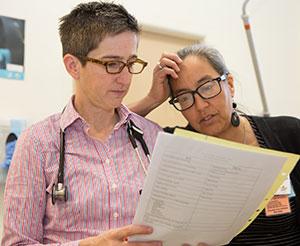 Beth Wilson with Dafna Wu, FNP, at Family Health Center, San Francisco General Hospital The most important contribution I make to the class is my perspective as a physician. For the NPs, the drum that I beat throughout the course is that NP training is short – there’s not a lot of time, and the amount of content we cover is stunning. The temptation for students, especially when you’re rushed in training, is to just memorize how to do something and be done with it, then go out and do it. Students tend to just want the answer – as do interns and medical students. So one of my messages for all of them is: That’s not the way it works. You have to think, because the answers change. Evidence changes. So you have to think critically, put pieces together and consider where you’re getting information. Who can you trust? I try to convey the murkiness of it; during lectures, almost every other slide is a contradiction.
Beth Wilson with Dafna Wu, FNP, at Family Health Center, San Francisco General Hospital The most important contribution I make to the class is my perspective as a physician. For the NPs, the drum that I beat throughout the course is that NP training is short – there’s not a lot of time, and the amount of content we cover is stunning. The temptation for students, especially when you’re rushed in training, is to just memorize how to do something and be done with it, then go out and do it. Students tend to just want the answer – as do interns and medical students. So one of my messages for all of them is: That’s not the way it works. You have to think, because the answers change. Evidence changes. So you have to think critically, put pieces together and consider where you’re getting information. Who can you trust? I try to convey the murkiness of it; during lectures, almost every other slide is a contradiction.
That’s what I learned in residency – and without that experience, those extra years, I’m not sure I would have understood it as well. NPs don’t have a set structure yet for residencies, but clinical decisions emerge from knowing how to think critically about each situation, and the physician trainees have more time to learn that in residency. If an NP is a brand-new grad, I would hope they have some form of structured support – someone with experience to help them, whether it’s an MD or another, more experienced NP – but I would also hope the same for someone who has just finished residency. With residents, I have more time to deliver that message, to watch them and work with them, but no matter what your discipline is, you have to be open to thinking critically, to honing that skill all the time.
As for the differences between NPs and physicians, there are stereotypes and misconceptions on both sides. For example, understanding social situations of patients is something some people claim doctors don’t do well, but I don’t think that’s true in family medicine, where we have more of a bent for that. On the other hand, one important stereotype for NPs to be proud of and draw on is that they come out of a nursing tradition and probably have more formal training around that social awareness than medical students. In the end, though, it doesn’t really help to put labels on any of our colleagues. Think about the misperception that all pharmacists do is dispense medication; but they do so much more, all sorts of fascinating things, including playing a very important role in chronic disease management. It’s so important to be exposed to different professions.
Now, in my new role as director of education, I’m working with Pilar Bernal de Pheils on the curriculum and structure of the program at the Family Health Center. It’s really a great learning environment, where clinical leads – one MD, one NP and one RN – share team leadership and build on each other’s strengths. It builds a real level of respect for what everyone brings. We try to walk the walk of everyone working to the top of their capacity.

